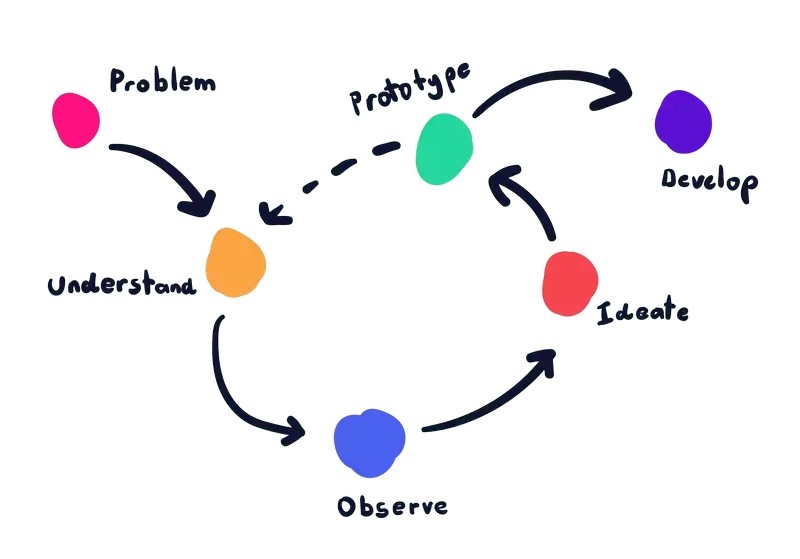All projects start somewhere, we believe they start with a problem. Whether it be customers or users not picking up the product as we hoped, a part of the business failing, or just an issue people have in life where we see an opportunity to help them. The first part of scoping a new project is always the same, understand what the problem is people are having.
This first part of the scoping process is centred around learning more about the problem, the people it affects, and why they are needing help to solve it. There are a series of activities you can do to help better understand the problem so you can be sure you’re going to make a winning solution.
Project cycle

The Codebots Scoping cycle is based off the Design Thinking cycle with a few tweaks to make it work for how we build software. The very first step is to start with a problem for the team to work on solving. What is important is understanding where that problem is coming from. Since every company is different and there are even more differences between internal and external clients here are a few ways that problems come in and how to treat them.
A client comes to you
For those who work in the design service or consulting space, this is the way the vast majority of projects start; clients seeking you out, asking to work with you on their next project. These problems are incredibly varied and come in all shapes and sizes, but they all have one thing in common.
The client and business is unable to solve these problems themselves. Whether it be that they have exhausted all their knowledge and still haven’t found a mark so they seek external help, or they simply do not have the team or resources to be able to execute their solution. For us as outsiders, it is our job to understand both the problem they need solving and why it is a problem they are having.
Part of the Understand stage is to learn more about the company and users, and utilise the knowledge the client has to build fantastic solutions.
A stakeholder presents a problem
When working on internal products, there will be various stakeholders asking you to solve their problems. Most companies will have several different stakeholders at the management level, all helping to contribute to the businesses products or process. For these people it is important for the scoping team to understand why they feel the need to work on this problem. Learning more about their role and goals they want to achieve with it, making sure that they are working towards the business goals as a whole and not using resources with little return.
As a team, it is always best to work directly with the stakeholders of this problem in as many ways as possible so that they have input in the solution the team comes up with. While you may be the professional problems solvers, they are the professionals at what the problem is going to be solving.
Proactive research of your users
A hallmark of a good product team is actively seeking out and understanding their users so they can start looking for ways to prevent problems, or tackle them before they become too big. This method of going out and observing and speaking with users is what our process does second, but there is nothing stopping you from doing it first to be proactive.
You see a need
Similar to the proactive research, this is when you or your team find a need or a problem in a market that no one is solving (at least not well) and decide to go and make a solution. This is where most start-ups spring from, and is a great way to create positive impact in a community. When seeking out the problem here, make sure you find a definition that resonates with the people you hope to build for.
Understanding the problem and users
The Understand stage is all about learning why the problem exists and who the people are that it is impacting. We normally start this stage off by having who ever is presenting the problem (whether it be the internal team, a stakeholder or a client) explain what they see as the crux of the issue. Have them explain why it is a problem, why that problem exists, what led to the problem arising, what have they tried to solve it, and what people do for work-arounds now. Getting them to explain as much information as they can up front about the problem is key for the team to gain the empathy needed create an impactful solution.
Even as they explain the problem, it is a good chance for them to explain the people who it affects. Whether it be customers or employees, they are the people you are going to need to talk to so you can learn more about the situation at hand. They are a treasure trove of information and it is always a better choice to get first hand accounts of the problem instead of what someone else thinks.
One of the dangers in this stage is to have a solution mindset. This is a way of thinking where the person presenting the problem, or the team, start saying how they are going to solve the problem based purely off these early discussions. This is bad practice as you have no idea if you are on the right track and sometimes people can get attached to these early ideas and create bias later. Having wisdom and experience in the problem solving space lets you get a good idea of where to start your concepts to be on the right track, but there is never a one-size-fits-all approach to solutions. The variables are too varied to provide any real impact.
Those presenting the problem might have certain business requirements or processes that need to be followed, these create positive constraints for the team to work around and should be considered as part of the solution. Remember that sometimes solving what the real problem is for people could mean those requirements or processes are no longer needed or provide any value.
Activities to try
Here are some activities you should do as part of the Understand stage to help learn more about the problem.
Defining the problem
Defining the problem - This is the number one most important activity in the entire scoping process. In fact it is the only mandatory one. This is the first activity you do in scoping and it is the one that has flow on affects to everything else. During this activity the team decides upon what the problem is, what the goals are and what success looks like. It creates a guiding light for the team to adhere to when coming up with concepts and solutions. Diving down and learning about the problem here makes sure everyone is happy with what people are going to build and becomes a measurable goal post at the end to see if you hit it.
User journey
User journey - The User Journey activity is all about understanding all the key points that people interact with the problem and how they go along the business process. This is especially handy when discussing existing projects and businesses.
Define your audience
Define your audience - In this activity, the team better understands who the audience is for your solution and gather any information about them you need before going to speak with them. This gets everyone on the same page for research and who to talk to.
Project journey
Project journey - The project journey is a chance for the team to layout and reflect on what direction they want to go with the scope and project, what they’ll need to prepare and who is responsible for what area.
Perspective cards
Perspective cards - This activity is great for helping the team understand and empathise with the users, stakeholders or clients on what they see. Feelings and emotions can sometimes be tricky to convey, but selecting from a deck of picture cards helps break down the communication barriers.
Business model
Business model - When looking at a new project, the business model is a handy activity to do so the team can make sure they adhere to the go to market strategy. It is also handy for the team to know what they need to prepare on a business level.




